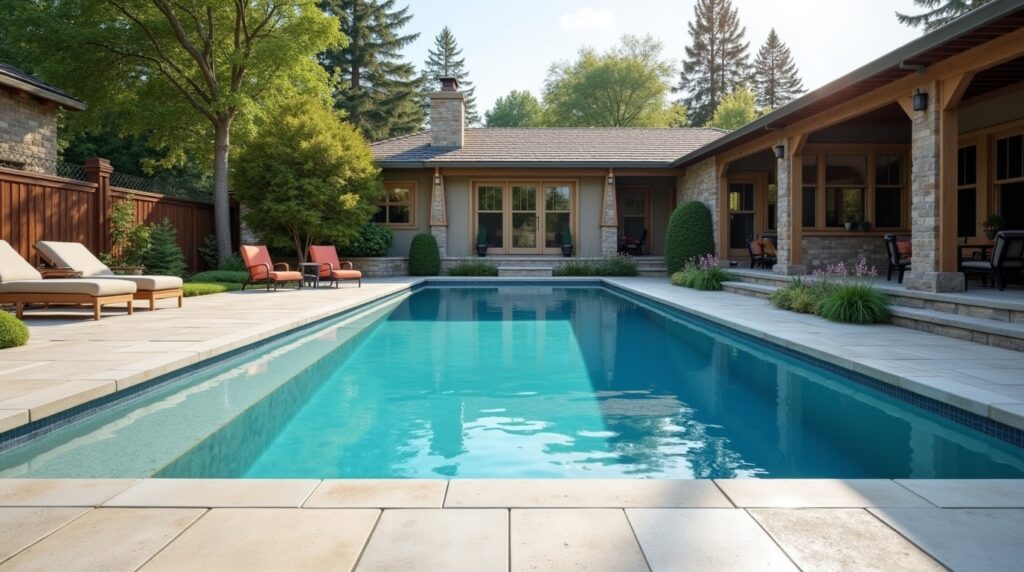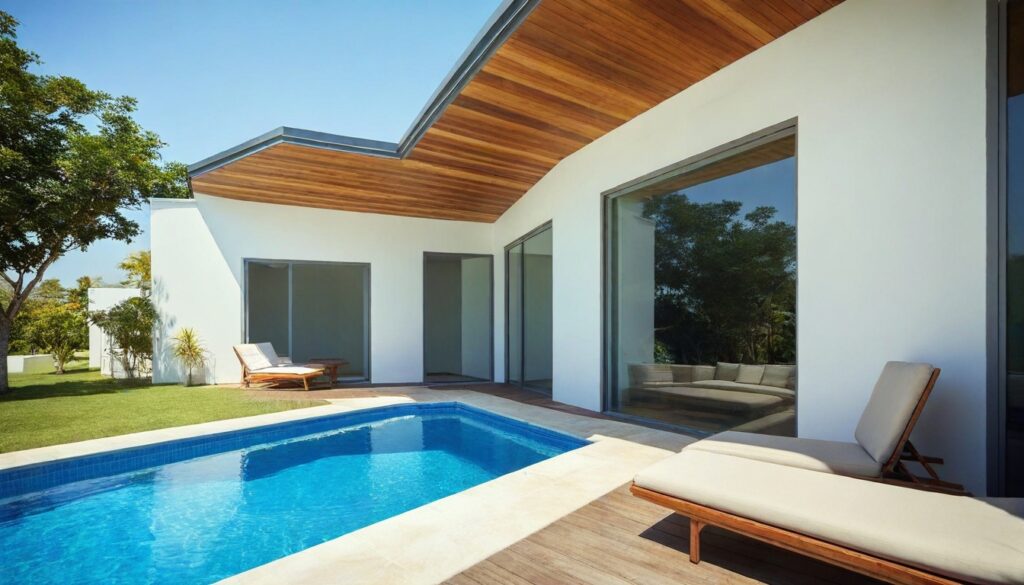For many Melbourne homeowners, choosing between a fibreglass or concrete pool is a key decision that shapes their entire backyard project. Each option comes with distinct advantages, but the right choice depends heavily on local conditions.
Melbourne’s unique climate, clay-rich soils, and diverse residential landscapes all play a role in determining which pool type will offer the best performance, longevity, and value. What works well on a coastal property in Brighton might not suit a sloped, leafy block in Camberwell. By understanding how these factors influence your options, you can make a smarter, more durable investment in your outdoor living space.
Melbourne’s Climate and Soil: What Pool Type Handles It Best
Melbourne’s varied climate and soil conditions create unique challenges for pool construction. The right pool type should offer stability, durability, and resilience against local environmental factors.To fully appreciate these challenges, it’s worth exploring the specific soil and climate conditions for pool building in Melbourne in greater detail.
Impact of clay-rich soils and ground movement
Many Melbourne suburbs sit on clay-heavy soils that expand and contract with moisture changes. This ground movement can place stress on pool structures over time. Concrete pools, when properly engineered, can be reinforced to handle these shifts effectively. Fibreglass pools are flexible to a degree, but incorrect installation on unstable soil can lead to shell distortion or cracking.
Seasonal temperature variations and pool shell resilience
Melbourne experiences hot summers and cool, damp winters. Concrete pools cope well with these fluctuations, thanks to their robust structure. Fibreglass shells are also designed to tolerate temperature swings, but sudden extreme shifts could increase the risk of micro-fractures in poorly supported installations.
Durability under Melbourne’s wet/dry seasonal cycles
The city’s alternating wet and dry seasons test pool durability. Concrete pools, with quality waterproofing and finishes, typically resist moisture-related damage over decades. Fibreglass pools offer excellent water resistance out of the box, but owners should ensure proper drainage around the shell to prevent issues caused by ground water pressure. For construction standards suited to these conditions, consult SPASA – Pool Construction Standards.
Installation Timeline and Construction Disruption
Beyond cost and aesthetics, installation time and site impact are crucial factors for Melbourne homeowners choosing between fibreglass and concrete pools.

Average installation time for fibreglass pools
Fibreglass pools are pre-moulded in a factory and delivered to the site ready for placement. This allows for faster installation — often within 1 to 3 weeks, depending on site conditions and weather. For busy urban areas in Melbourne, this reduced timeline means less disruption to daily life and neighbouring properties.
Complexity and customisation in concrete pool projects
Concrete pools offer unmatched design flexibility, but this comes at the cost of longer construction times. Depending on complexity and custom features, a concrete pool in Melbourne may take 8 to 12 weeks or more to complete. Factors such as weather delays and site access can further extend the timeline.
Impacts on access and surrounding landscaping in Melbourne properties
Both pool types require excavation and machinery access, but concrete projects generally involve a longer period of disturbance. In tightly packed Melbourne suburbs, this can affect neighbours and existing landscaping. Careful planning is essential to minimise damage and ensure the site is restored effectively.
Cost Comparison in a Melbourne Context
Understanding both the upfront and long-term costs of fibreglass versus concrete pools is key to making the right decision for your Melbourne property.
Initial installation costs
Fibreglass pools generally offer a more budget-friendly upfront cost. Their pre-moulded construction and faster installation process reduce labour expenses. In contrast, concrete pools involve more custom work and longer build times, which increases the overall initial investment. For a complete picture of all contributing factors, it’s helpful to review the average cost of building a pool in Melbourne.
Ongoing maintenance and repair expenses
Concrete pools may require more frequent surface maintenance over time, such as re-sealing or re-tiling, especially in shaded or debris-prone areas common in Melbourne’s leafy suburbs. Fibreglass pools, with their smooth gelcoat surface, typically resist algae and staining better, reducing cleaning and chemical use.
Resale value and buyer preferences by suburb
In prestige suburbs like Brighton or Camberwell, custom concrete pools can add significant resale appeal due to their high-end, tailored designs. However, in middle-ring suburbs, well-installed fibreglass pools are increasingly popular, offering a balance of value, low maintenance, and modern style that appeals to busy families. For regulatory considerations that may affect costs, visit the VBA – Swimming Pools and Spas.
Design Flexibility: What Melbourne Homeowners Are Asking For
Concrete pools provide unlimited customisation, allowing homeowners to create pools in any shape or size. This is ideal for complex sites, sloping blocks, or those wanting unique features such as integrated spas, water features, or designer finishes.
Custom shapes and finishes with concrete
Concrete pools provide unlimited customisation, allowing homeowners to create pools in any shape or size. This makes it the ideal choice for complex projects, such as figuring out how to install a pool on a narrow block, or for homeowners wanting unique features like integrated spas that match the home’s architectural elements.
Pre-moulded options and limitations of fibreglass
Fibreglass pools come in a range of popular shapes and sizes but are restricted to what can be transported and installed as a single shell. While modern designs are sleek and functional, they may not suit properties with unusual layouts or specific design visions.
Pool design trends in suburbs like Brighton, Camberwell, Glen Iris
In affluent areas like Brighton and Camberwell, custom concrete pools remain a strong choice for those seeking high-end finishes and integration with landscaped gardens. In Glen Iris and similar suburbs, fibreglass pools are popular for their clean lines, speed of installation, and lower maintenance, fitting well with contemporary family homes.
Local Council Regulations and How They Affect Your Choice
Melbourne’s pool regulations can influence whether fibreglass or concrete is the better choice for your property. Approval timelines, documentation, and engineering requirements may vary depending on the pool type and location.

Approval timelines by pool type
Fibreglass pools often receive faster council approval because they involve standardised designs and simpler engineering. Concrete pools, with their custom features, usually require more detailed assessments and can face longer approval processes, particularly if the design includes unusual elements or is in a sensitive planning zone.
Engineering documentation requirements
Concrete pools typically need more extensive engineering documentation, including structural reports and soil assessments, especially on sloped or clay-based sites. Fibreglass pools also require engineering certification, but the process is generally more streamlined. For official guidance, refer to the VBA – Swimming Pools and Spas.
Examples from Boroondara, Stonnington, Bayside councils
Councils like Boroondara may impose stricter requirements for heritage overlays or tree protection zones, impacting concrete pool approvals in particular. Stonnington and Bayside councils often have detailed stormwater and landscaping conditions that can affect both pool types, but especially more complex concrete designs.
Long-Term Durability and Maintenance in Melbourne Conditions
Choosing the right pool material for Melbourne conditions means considering how it will perform and what maintenance it will require over time.
Wear resistance in shaded or debris-prone backyards
Concrete pools can be finished with high-quality tiles or renders that resist staining from organic debris — a common concern in Melbourne’s leafy suburbs. Fibreglass’s smooth gelcoat also helps minimise algae growth and staining, making cleaning easier in shaded gardens.
Fibreglass osmosis risks vs. concrete surface erosion
Fibreglass pools may, over time, face the risk of osmosis (blistering caused by water penetration), though modern manufacturing has greatly reduced this issue. Concrete pools, on the other hand, can experience surface erosion or cracking if not properly maintained or waterproofed, particularly on challenging soil types.
Best materials for low-maintenance pool ownership in Melbourne
For low-maintenance ownership, fibreglass pools generally require less frequent resurfacing and chemical treatments. Concrete pools can also be low-maintenance if finished with durable materials and maintained correctly. Builders following SPASA – Pool Construction Standards (lien #1 : “SPASA – Pool Construction Standards”) guidelines ensure longer-lasting results for both pool types.
Frequently Asked Questions (FAQ)
Is fibreglass or concrete better for Melbourne’s clay soil?
Both pool types can perform well on clay soil if installed correctly. Concrete offers greater customisation for engineered footings, while fibreglass can work effectively with proper site preparation and drainage
Which pool type has lower maintenance costs in Melbourne?
Fibreglass pools generally have lower ongoing maintenance costs due to their smooth surface, which resists algae and reduces chemical use. Concrete pools may require occasional resurfacing or tile repairs over time.
Are concrete pools harder to get approved by Melbourne councils?
Concrete pools often involve more detailed design and engineering, which can lengthen approval times compared to fibreglass pools. Councils may also impose additional requirements for custom concrete designs, especially in heritage or sensitive zones.
Can a fibreglass pool be installed on a sloped block in Melbourne?
Yes — fibreglass pools can be installed on sloped sites, but they typically require additional excavation, engineered retaining structures, or built-up platforms to ensure stability.
Which type lasts longer in Melbourne’s weather conditions?
Both fibreglass and concrete pools can last for decades in Melbourne if properly built and maintained. Concrete may have an edge in terms of longevity, especially when high-quality finishes are used and regular maintenance is performed.
Choosing between a fibreglass or concrete pool in Melbourne comes down to balancing your priorities — budget, design flexibility, long-term durability, and how well the pool suits local climate and soil conditions. Both pool types have their advantages, but the best choice is the one that fits your property’s unique characteristics and your family’s lifestyle.
Engaging a local pool builder experienced in both technologies ensures you get expert advice tailored to Melbourne’s environment. For further guidance on standards and regulations, consult SPASA – Pool Construction Standards and VBA – Swimming Pools and Spas.
